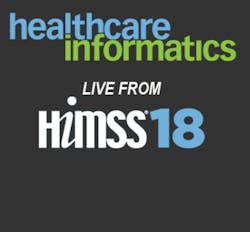This week, Google announced the launch of its Cloud Healthcare API, which is calls a “robust, scalable infrastructure solution to ingest and manage key healthcare data types.” And during a keynote speech at HIMSS18 on Monday, Eric Schmidt, former executive chairman of Google, outlined his vision of a truly connected, fully AI-assisted learning healthcare system, and how cloud technology is a foundational building block to that.
“I’m going to start with, get to the cloud, run to the cloud. Take an airplane, fly to the cloud. Most of you sit in data centers that work on proprietary logic. We now have cloud technology available, from Google and others, that’s much safer than your data center, much more compliant than your data center,” Schmidt said during his speech to HIMSS18 attendees.
Allscripts CEO Paul Black also is bullish on cloud technology in healthcare: “There’s no question that the cloud is going to be a big factor in bringing down the total cost of ownership,” he said. “It’s something we’re focused on—Practice Fusion [an electronic health record platform] is cloud-based, many of our solutions are cloud-based. We recently put Sunrise into [Microsoft] Azure, so we’re actively moving applications to the cloud. There’s no question that in five years, 10 years, most of the applications that hospitals access will be cloud-based.”
In an exclusive interview with Healthcare Informatics Associate Editor Heather Landi at HIMSS18 in Las Vegas, Black discussed the company’s latest developments to incorporate machine learning into the EHR, interoperability efforts as well as how the Chicago-based EHR technology company is helping providers and government and public health leaders address the opioid crisis.
On Tuesday morning, Centers for Medicare & Medicaid Services (CMS) Administrator Seema Verma announced a broad new initiative, called MyHealthEData, to empower patients to control their health data. In response to that announcement, Black said, “We welcome that, we encourage it. We have been talking about interoperability and open API (application programming interface) access for a long period of time. We’ve been doing that and offering that to our clients for the past 10 years.”
He added, “We think to have true interoperability you need to allow that level of access to the data, allow patients to have access and to pull that data out. We also believe, at the end of the day, that it’s the patient’s record and they should have full access to it.”
Black continued, “This dialogue is a natural progression of the digital framework as a result of the stimulus act in 2009 [American Recovery and Reinvestment Act]. The good news is, we’re all digital; the bad news, or the challenge is, we have all these different EMRs, we now have 400 different EMRs. So, interoperability, from my position, is a high-class problem. We have technically solved it, so let’s now talk about workflow and how to make that data that resides in different EMRs more usable to the clinician and more useable to the patient.”
Black also said that “intra-operability” or interoperability within vendor networks is not sufficient. “So how does Epic interface with Epic? While that’s interesting, it’s not enough. Epic has 15 percent of the marketplace, globally, therefore, 85 percent can’t connect to that. You have to be able to pull information out and harmonize that information. There is a workflow component that harmonizes the information and that’s a piece of the interoperability discussion, let’s talk about the harmonization of that data.”
Allscripts touts its open platform as well as its relationships with entrepreneurs and healthcare providers. In December, the company announced it hit an industry milestone of one billion API data exchange transactions in 2017. The Allscripts Developer Program (ADP) has certified 200 distinct applications and devices for its users, which are available through the company’s application store.
Black also addressed a blog post he wrote, which was published last Friday, criticizing a recent report from Orem, Utah-based KLAS Research examining interoperability efforts by CommonWell and Carequality. The vendor is an original CommonWell member—but has not yet signed up with Carequality.
The report, “Interoperability: An Inside Look at Plug-and-Play Patient-Record Sharing,” concluded that CommonWell Health Alliance’s interoperability services currently lack value. The report asserted that CommonWell's interoperability efforts are being hindered by a lack of provider adoption, but when CommonWell and Carequality eventually connect, “instant value” will be created for users, the KLAS report stated.
In his blog post, Black said the report looks at interoperability through a specific lens—connectivity through “plug-and-play” services—and he called that approach, “short-sighted and dangerous.”
Expanding on that blog post, Black said, “To me, in that report, KLAS narrowed the classification of what interoperability was. The definition was too narrow, it didn’t incorporate point-to-point interfaces, local health information exchanges (HIEs) and APIs. To us, those are a wider and more accurate definition of what interoperability is, versus a narrow definition of ‘Do you connect to a plug-and-play network?’”
He added, “The report had a narrow focus on a much broader, important topic of interoperability, and especially in light of what happened with the CMS [announcement]. We need to make sure there is a broad definition of what interoperability is,” he said.
EHR Innovation, and Using Data to Address the Opioid Crisis
In the past several years, EHR vendors had to devote resources and energy to developing clinical information systems that met Meaningful Use requirements and obtain Office of the National Coordinator for Health IT (ONC) certification. Now, many EHR vendors are focused on innovating in areas such as population health, patient engagement platforms, care management and post-acute care.
Back in January, Allscripts announced it was acquiring Practice Fusion, a cloud-based EHR platform, which significantly expands its EHR business, as 30,000 ambulatory practices currently use Practice Fusion’s EHR. Allscripts leaders said the acquisition would expand the company’s big data insights and analytics, data sharing technologies, and clinical trial solutions. That deal came six months after Allscripts announced it would pay $185 million to acquire McKesson’s hospital and health system IT business, Enterprise Information Systems, which included the Paragon EHR. That deal expanded Allscripts’ footprint in U.S. large practice health systems.
This week, during the HIMSS18 conference, Allscripts announced the launch of a mobile, cloud-based EHR solution that uses machine learning to reduce time for clinical documentation. The solution is designed to work like an app instead of traditional software, the company said.
The new EHR product, Avenel, is named after Virginia Avenel Henderson, considered to be one of history’s most powerful women in nursing; she was also a researcher, theorist and author. Built on Microsoft Azure, the Avenel solution streamlines workflow and integrates clinicians’ treatment patterns and then provides reminders of preferences to facilitate faster documentation and decision making.
“There is a growing concern in the marketplace about physician fatigue and issues around how they are spending an increasingly large amount of time with the computer versus the patient. We felt that it was time for a brand new EMR to be built where the EMR would actually work for the physician, versus the physician having to work with the EMR. From an end-user design standpoint, we felt that this could be disruptive,” Black said.
The cloud-based solution also delivers a shared record to facilitate care coordination, Black said. “For primary care, we think this is an extraordinarily important application,” he said.
Black also shared how Allscripts is working to help address the opioid crisis, as the Centers for Disease Control and Prevention (CDC) reports that prescription opioid use and overdoses have quadrupled since 1999.
As a result of its technology solutions, Allscripts has access to a large volume of prescription information, from 70,000 primary care physicians throughout the U.S. “We can see where opioids are being prescribed, and by de-identifying the patient data, we can see where opioid hot spots are and see how many times a prescription has been given and also see the progression of opioid dependency,” Black said. Predictive analytics using prescription data can help predict the progression of the path to addiction, from less addictive opioids to more additive opioids, such as fentanyl, he noted.
“We can see geographies by zip code, by county, to see where there are issues. We can look at the total population of a county with a high incident of opioid usage and plug in the county or state data from registries. And, we’re taking that data back to state governors so they can take it to their opioid task forces to help identify opioid hot spots,” he said.
Black noted the potential to better leverage technology to expand the response to the opioid crisis to be more proactive, and ultimately, predictive. “State governments are tamping down on the electronic prescription of controlled substances; there is a fair amount of technology that you can utilize to help with abusive practices. The technology is there, and it can help with reducing the number of prescriptions,” he said, adding, “The technology is in place and we can leverage that technology to get people connected to the social fabric that already exists, such as addiction treatment centers and behavioral health, to help people in need.”
Black also addressed the recent developments around technology firms, such as Apple, Amazon and Google, making big health care moves. “There’s a lot of big players coming in and they are coming in with a different focus than what folks have done in the past. They are going to be focused on data, on AI, and population health, which we welcome. We also think those are capabilities that we share, so in some cases, we will be competing.”
He continued, “They are also focused on consumers, and that’s also something that we welcome as getting consumers engaged in their healthcare is needed for us to break the overall cost of healthcare.”


